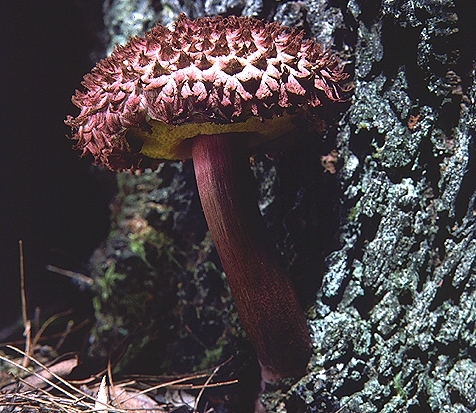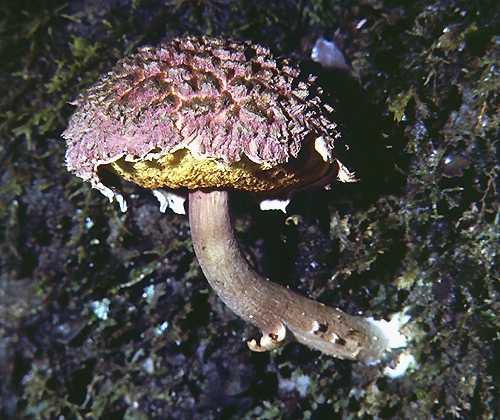
Boletellus emodensis (Berk.) Singer

Common name: None.
Description: The caps are normally up to 6 cm in diameter, but some larger caps do occur. The surface of the cap is heavily shaggy with large scales that give the overall impression of a pine cone, especially when the fungus is just expanding. The scales are pink, but there are variants with mostly brown scales and only pinkish tints between the scales. The pores are bright yellow and immediately stain blue-green on bruising. With age the pores become deep, dull yellow. At first the pores are protected by a veil that stretches from the stem to the cap margins. As the cap expands, the veil often remains as fragments hanging from the cap margins. The cap flesh is white and thick and instantly becomes blue when it is cut. The stem can be up to 10 cm long and up to 1 cm thick. It is reddish-tinted near the pores and greyish brown below. The stem surface is usually smooth and dry and there is no ring.
Spores are 1620 × 79 µm and are long-ellipsoidal with diagonal striations running down the length of the spore surface; they are brown-tinted. Microscopic examination (100 oil immersion lens required) shows cross striae between the diagonal striations.
Substratum: On old logs in eucalypt or Nothofagus (beech) forests or mixed rainforest. In some areas it is particularly associated with large forest forms of Casuarina (she-oak). Usually solitary or in twos or threes.
Distribution: Known from Queensland, New South Wales, Victoria and Tasmania.
Notes: There are a number of closely related varieties or species in this group. Boletellus ananiceps is very similar but has no cross striae on the spores (Grgurinovic 1997).
A similar but unrelated species, Strobilomyces pallescens, has brown pores and does not turn blue-green. Microscopically the two are easily distinguished as species of Strobilomyces have more or less globose spores with a network decoration on them, but Boletellus spp. have elongated spores with diagonal striations.

